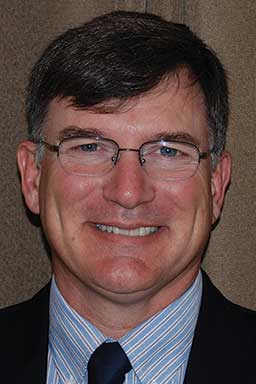It is an honor to be nominated to run for the position of vice president of the AASV. For the past 27 years I have bellied up to the AASV buffet and have consumed a tremendous amount. By potentially serving in this capacity, I could give back a small amount of time and effort in return for the vast amount that I have consumed. The AASV has served as the fuel for my career. I have used AASV not only for knowledge gain, but for networking, support, new product discovery, sometimes chastisement, friendships, etc. Without AASV, it would be very difficult to stay current and connected.
I grew up on a small diversified farm in northeast Nebraska. I was the oldest of four boys and my father made it clear when I was young that the opportunity for me to stay home and farm was not good. So, when I was 9 years old, I declared that I was going to be a veterinarian. I really had very little idea what that would entail, but somehow, 15 years later, I graduated from Iowa State with my DVM. I started in 1988 and was fortunate to experience a mixed-animal, “James Harriot” type practice for nearly 9 years. But, as we all know, nothing stays the same. Our clientele morphed from small farrow-to-finish operations to cooperatively owned sow reproductive centers with two- and three-site production. Along with veterinary medicine, we began to be asked to deal with human-resource issues, book-keeping, record-keeping, building design, contractual agreements, etc. In 1997, I decided to partner with an accountant and opened a swine management company and veterinary practice. We have endeavored to do this ever since.
One of the biggest dichotomies in life and practice is that change is constant. I remember talking with older veterinarians about how they thought that, as soon as hog cholera was eradicated, swine veterinary practice would pretty much be done. Similarly, many worried that as soon as pseudorabies virus (PRV) was eradicated, swine medicine would flounder. When I graduated from veterinary school in 1988, swine medicine was primarily bacterial diseases and PRV. There was, however, an emerging problem called “mystery swine disease” that was starting to make some noise. It turns out that initial noise was the tip of a massive emerging iceberg. After nearly 30 years, porcine reproductive and respiratory syndrome (PRRS) still has a massive impact. While we have been dealing with PRRS, there has been a revolving door of new or re-emerged diseases popping up constantly. The diseases of swine will continue to change and will continue to provide our profession with a challenge and something to do.
When I graduated, biosecurity was a change in coveralls and a bucket of disinfectant with a boot brush. Now we have truck washes with baking bays, filtered barns, and strict biosecurity standard operating procedures. A large sow unit was anything over 500 sows. Now, some question if anything under 3000 is feasible long-term. Pig farm labor was performed by land-based farmers and their families. Now, the labor force is culturally diverse, male or female with or without any history of livestock background. Producers were free to raise pigs in basically any way they deemed right or convenient. Today we have “PQA,” “TQA,” “CSIA,” and “VFD” with more acronyms to come. The swine industry itself will continue to change and also will continue to provide our profession with a challenge and something to do.
I am reminded of an old joke which I’ve modified some. How many swine veterinarians does it take to change a light bulb? The answer is five. One to change the bulb, two to talk about how good the old bulb was, and two to make an acronym for the new light bulb. As swine veterinarians, we can sit back and talk about the good old days and lament the current climate, or we can roll up our sleeves and attack the future. What will the future bring? No one knows for sure, but with an organization like AASV we can come together and prepare. We are a massively diverse organization with unending ideas and resources. Yet we are small enough to be nimble, intimate, and responsive. As professionals that are looked to for advice, encouragement, and input, we need to prepare ourselves to be competent in all of these aspects. The AASV can and will be the backbone for that preparation.
If elected, I will be honored to be part of the team that helps AASV adapt and move forward with the changes that we currently face and the ones yet to come.

